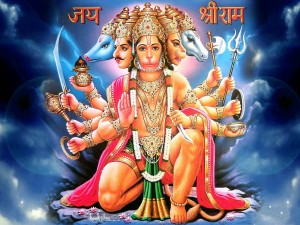 Hanuman Jayanti is observed twice annually in the Hindu calendar. The 14th or chaturdashi day in the dark fortnight of the Kartik month (also the day before Divali is observed) is recognised as the day when Hanumanji manifested as the son of Anjani.
Hanuman Jayanti is observed twice annually in the Hindu calendar. The 14th or chaturdashi day in the dark fortnight of the Kartik month (also the day before Divali is observed) is recognised as the day when Hanumanji manifested as the son of Anjani.
The second observance is on the Chaitra Poornima or the Full Moon Day of the month of Chaitra (March-April). According to Raamaayan Kathaa, it was on this day that Shree Hanumanji acquired powers from Devi Maataa, Indra and other forms of divinity, making Him a source of unbounded power, strength and knowledge. This Hanuman Jayanti, well-known to Hindus everywhere, follows the extremely auspicious, nine-day period of Nav Raatri, the period of worshipping the Divine Mother.
The worship of Shri Hanumaan can be performed in a variety of ways. A few of them have been outlined below. This saadhan or spiritual discipline is most efficacious. Worship of this form of God can be done in any or all of the following ways:
- Simple Hanumaan pooja can be done using water, chandan, flowers, incense, perfume, aarti and Prasaad.
- Havan can be also performed.
- The chanting of Hanumaan Chaalisaa, Sundar Kaand and other Hanumaan stotra can be done also.
- Offerings of charity can be made.
Some of the benefits of worshipping Shri Hanumaan are as follows:
- One is freed from the five kleshas (mental afflictions) which cause misery, perversion and negative tendencies. These kleshas are: Avidyaa – ignorance; Asmita – egoism; Raag – attractions; Dwesha – dislikes and Abhinivesh – fear of death.
- Improvement in one’s physical health condition and mental stability; stamina is also increased.
- One acquires the power to overcome obstacles and dangers of any kind.
- One gains mastery over the animal instincts and evolves mentally to the state of Divine Consciousness.
- Control of the mind.
- Difficulties, mental depression and other stress-related conditions are reduced.
- Wherever worship of Hanumaanji is done, evil spirits are warded off.
The Hanumaan Chaalisaa
Tulsidas composed the Hanumaan Chaalisaa, a concise biography of Hanumaanji, in poetic form. The sage poet was very ill at the time. In his debilitated physical condition, he sang the praises of the Lord, in this poem of forty lines. Shortly after, he recovered. This composition is said to have miraculous powers, ensuring freedom, fulfilment, peace and happiness to the devotees who chant it. It is advisable that the chanting of the Hanumaan Chaaleesaa should be done on Tuesdays and Saturdays, if not everyday.
Reading/ Chanting of Sundar Kaand
The Sundar Kaand is the fifth volume of Shri Raamcharitra-maanas, written by Goswami Tulsidas. It focuses mainly on the adventures of Shri Hanumaanji in Lanka, on His search for Sita Devi, who was kidnapped by Raavan. In this volume, the powers of this devotee of the Lord are depicted.
- Qualities such as patience, dependability, endurance and strength are all highlighted as Hanumaan battles his way in the face of adversity.
- The chanting of the Sundar Kaand is a form of worship of Hanumaanji that helps one to develop the qualities outlined above.
- It offers a beacon of hope for the devotee in search of spiritual enlightenment.


